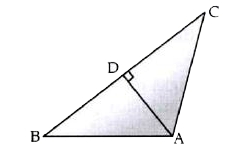In a rhombus prove that sum of squares of sides is equal to sum of square of diagonals or, In a rhombus ABCD prove that
AB2+BC2+CD2+DA2=AC2+BD2
To prove that in a rhombus ABCD, the sum of the squares of the sides is equal to the sum of the squares of the diagonals, we will follow these steps:
1. Identify Properties of a Rhombus:
- In a rhombus, all sides are equal. Therefore, we can denote the length of each side as s.
- The diagonals bisect each other at right angles.
2. Express the Sides:
- Since all sides are equal, we have:
AB=BC=CD=DA=s
- Therefore, the sum of the squares of the sides can be expressed as:
AB2+BC2+CD2+DA2=s2+s2+s2+s2=4s2
3. Label the Diagonals:
- Let the diagonals AC and BD intersect at point O.
- Let AO=AC2 and BO=BD2.
4. Use the Right Triangle Property:
- In triangle COB, which is a right triangle:
CB2=OB2+OC2
- Substituting OB=BD2 and OC=AC2:
s2=(BD2)2+(AC2)2
- This simplifies to:
s2=BD24+AC24
5. Multiply by 4:
- To eliminate the fractions, multiply the entire equation by 4:
4s2=BD2+AC2
6. Final Conclusion:
- We have shown that:
AB2+BC2+CD2+DA2=4s2=AC2+BD2
- Thus, we conclude that:
AB2+BC2+CD2+DA2=AC2+BD2
- This proves that the sum of the squares of the sides of a rhombus is equal to the sum of the squares of its diagonals.
- In a rhombus, all sides are equal. Therefore, we can denote the length of each side as s.
- The diagonals bisect each other at right angles.
- Since all sides are equal, we have:
AB=BC=CD=DA=s
- Therefore, the sum of the squares of the sides can be expressed as:
AB2+BC2+CD2+DA2=s2+s2+s2+s2=4s2
- Let the diagonals AC and BD intersect at point O.
- Let AO=AC2 and BO=BD2.
- In triangle COB, which is a right triangle:
CB2=OB2+OC2
- Substituting OB=BD2 and OC=AC2:
s2=(BD2)2+(AC2)2
- This simplifies to:
s2=BD24+AC24
- To eliminate the fractions, multiply the entire equation by 4:
4s2=BD2+AC2
- We have shown that:
AB2+BC2+CD2+DA2=4s2=AC2+BD2
- Thus, we conclude that:
AB2+BC2+CD2+DA2=AC2+BD2
- This proves that the sum of the squares of the sides of a rhombus is equal to the sum of the squares of its diagonals.
Topper's Solved these Questions
- QUADRILATERAL BOOK - LUCENT PUBLICATIONCHAPTER - QUADRILATERAL EXERCISE - Exercise 7A
31 Videos
- QUADRILATERAL BOOK - LUCENT PUBLICATIONCHAPTER - QUADRILATERAL EXERCISE - Exercise 7B
6 Videos
- LINES AND ANGLES BOOK - LUCENT PUBLICATIONCHAPTER - LINES AND ANGLES EXERCISE - EXERCISE 4B
5 Videos
- TRIGONOMETRIC RATIO OF SPECIFIC ANGLESBOOK - LUCENT PUBLICATIONCHAPTER - TRIGONOMETRIC RATIO OF SPECIFIC ANGLESEXERCISE - Exercise 10B
10 Videos
Similar Questions
Knowledge Check
Each side of a rhombus is 10 cm, the sum of square of its diagonal is
AA)20 cm2BB)200 cm2CC)400 cm2DD)100 cm2If each sides of a rhombus is 10 cm then what is the square root of sum of square of its diagonals ?
AA)10√10cmBB)20 cmCC)10√20cmDD)20√10cm
For a rhambus ABCD , prove that 4AB2=AC2+BD2
View SolutionIn rhombus ABCD, show that 4AB2=AC2+BD2
View SolutionIn fig., if AD⊥BC, prove thatAB2+CD2=BD2+AC2.
View SolutionIn Figure 2,AD⊥BC. Prove that AB2+CD2=BD2+AC2.
View SolutionProve that the sum of the squares of the sides of a rhombus is equal to the sum of the squares of its diagonals.
View SolutionIn the given figure if AD ⊥ BC prove that AB2+CD2=BD2+AC2

View Solution
